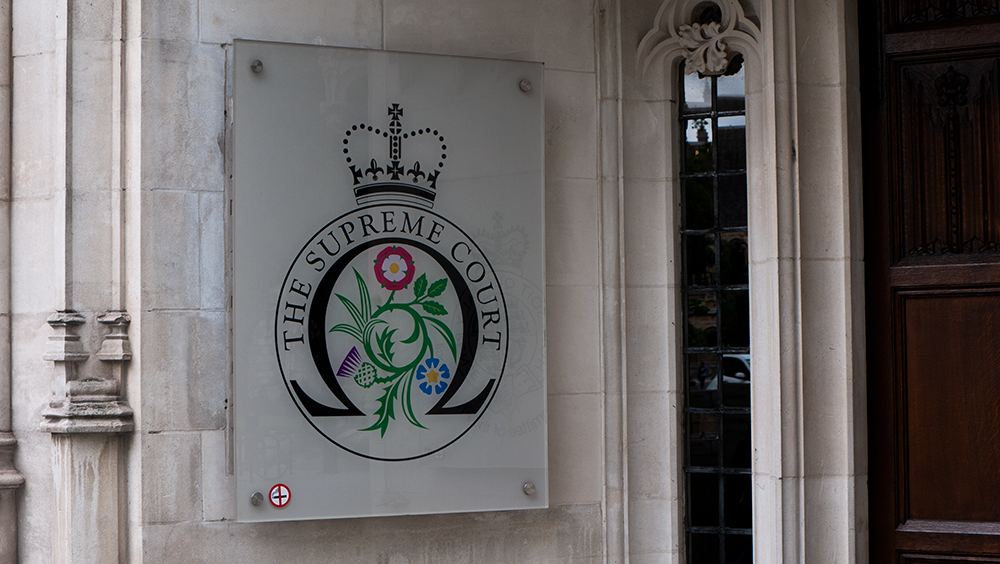UK Supreme Court: Northern Ireland appeal concerning construction of defence statements dismissed

The UK Supreme Court has considered, in a case originating from Northern Ireland, the question of whether the interpretation of defence statements in jury trials is a matter for the trial judge or jury.

About this case:
- Citation:[2025] UKSC 17
- Judgment:
- Court:UK Supreme Court
- Judge:Lord Hamblen
Delivering judgment for the Supreme Court, Lord Nicholas Hamblen stated: “In evidence the appellant confirmed the contents of para 4(n) and stated what she understood or intended it to mean. The judge questioned her by reference to how he considered that it would be understood by the person reading the defence statement. That raises a question of fact.”
Background
On 28 February 2018, the home of the appellant, a self-described journalist, activist and a member of the Irish republican political party Saoradh, was searched by police.
The search located coded notes handwritten on cigarette papers, stored in a perfume box, which were believed to refer to individuals ciphered using initials and to relate to a 2015 search operation which had resulted in the conviction of a Kevin Nolan for possession of firearms, ammunition and explosives.
At the appellant’s non-jury trial, the prosecution contended that the notes and sequence of events described represented a debriefing exercise conducted by dissident republicans and was designed to provide practical assistance to a person committing or preparing acts of terrorism in the future.
At paragraph 4(n) of her defence statement, the appellant contended that:
“original notes were forwarded to the Defendant some considerable time after the events giving rise to Kevin Nolan’s conviction and were forwarded after Kevin Nolan was sentenced. Any currency in the information contained in the notes was considered by the Defendant to have long since dissipated. The Defendant did not think that the information in the notes, at the time at which she received them, would be of any future use to anyone in any sinister way. Any ‘usefulness’ or utility that the information might once have had (which utility is not accepted) had been spent. She believes that this was partly why the notes were considered suitable for sending to her at that time.”
The statement claimed that the appellant considered the papers to have been sent to her in connection with her work writing on issues relating to policing and the MI5 and that she had made handwritten copies thereof, later disposing of the originals.
The appellant denied ‘collecting’ information and that her handwritten copying of the papers was the making of a record, ultimately suggesting that she had a reasonable excuse for possessing the notes.
The trial judge concluded inter alia that the “obvious meaning” of the appellant’s contention at para. 4(n) of her defence statement in relation to the currency of the information had dissipated was that the appellant knew that the notes related to the 2015 arms search and Mr Nolan’s conviction.
The trial judge opined that this was inconsistent with oral evidence given by the appellant to the effect that the notes made little or no sense to her, refusing to believe the appellant’s evidence in relation to the notes and convicting her of the offence of collecting or making a record of information likely to be useful to a terrorist, contrary to s.58(1)(a) of the Terrorism Act 2000.
Court of Appeal
The appellant appealed against her conviction on the basis that the trial judge erroneously relied on a finding that her evidence had departed from her account in her defence statement in making a further finding that her evidence was untruthful.
In particular, the appellant contended that the trial judge erroneously interpreted the first two sentences of para 4(n) as being connected, concluding that the appellant knew the notes related to a conviction and sentence which had long since been passed and so their utility was spent.
The appellant suggested that the first sentence thereof merely provided a temporal framework for when the appellant received the notes and that the second sentence indicated the appellant’s attitude to the notes when she received them, in that she believed they were sent to her because their utility must have been spent.
In its 2023 judgment dismissing the appeal, the Court of Appeal considered the interpretation of the defence statement raised a question of law and that no error in the trial judge’s construction could be identified. Further, the Court of Appeal determined that the interpretation of the defence statement was instead a question of fact, the judge’s assessment of the meaning of the defence statement was justified and “irresistible”.
On 23 February 2024, the Court of Appeal refused leave to appeal but certified a question of law of general public importance concerning whether in the context of a jury trial, the construction of the defence statement provided pursuant to Part 1 of the Criminal Procedure and Investigations Act 1996 is a question of law for the trial judge.
The Supreme Court
At the outset, Lord Hamblen noted that the answer to the certified question would depend on the nature of the statement made in the defence statement and the purpose for which it was being relied upon, with issues as to the legal effect of the document being a matter for the judge and issues as to the meaning intended or understood by the parties being matters for a jury.
Finding that in the appeal before the court, the issue was the meaning of the defence statement as understood or intended by the appellant, the judge explained that same was an question of fact and that the circumstances in which an appellate court could go behind a judge’s finding of fact were limited.
Accordingly, Lord Hamblen considered that the appellant was required to show either that the trial court misdirected itself in law or that a plainly wrong or perverse conclusion had been reached on the facts.
Noting that the appellant had not suggested that the judge had misdirected himself in law, but rather, that the interpretation of the defence statement was perverse as same was contrary to the ordinary meaning of the words used and was wrong, Lord Hamblen disagreed with the alleged perversity and found that the natural inference to be drawn from the defence statement was that the relevant sentences were connected.
The court further considered that the trial judge’s interpretation of the defence statement was not determinative of his conclusion that the appellant lacked credibility, with his judgment setting out further cogent reasons for so concluding.
Lord Hamblen highlighted that in circumstances where the finding of fact had been upheld by the Court of Appeal, the matter before it constituted an appeal against concurrent findings of fact of the lower courts which “only in very rare cases” could be disturbed by the Supreme Court.
Conclusion
Accordingly, the Supreme Court dismissed the appeal.
The King v Fionnghuale Mary Theresa Dympha Marie Nuala Perry [2025] UKSC 17









